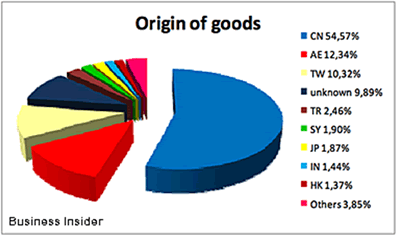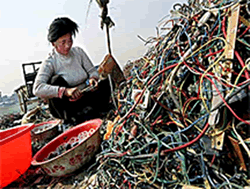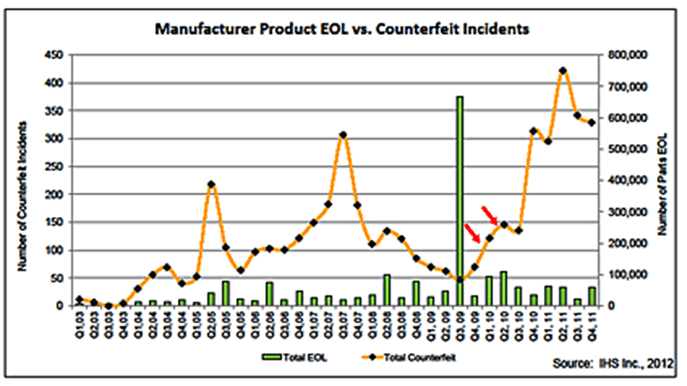Challenging the Counterfeit Connector Conundrum
Challenging the Counterfeit Connector Conundrum
 Every day, it seems like we hear about another bogus product being foisted on an unsuspecting public. In some situations, we are willing to accept substitutions for the real thing. For instance, we’ll accept facsimiles in order to have a Santa in every mall. But maintaining a childhood fantasy is one thing — a defective bolt in a commercial airliner is entirely different.
Every day, it seems like we hear about another bogus product being foisted on an unsuspecting public. In some situations, we are willing to accept substitutions for the real thing. For instance, we’ll accept facsimiles in order to have a Santa in every mall. But maintaining a childhood fantasy is one thing — a defective bolt in a commercial airliner is entirely different.
First it was Rolex watches, then Gucci handbags. Over the years the list has grown to include all types of name brand clothing, computer software, perfume, climbing equipment, nuts and bolts, consumer electronic devices, and even premium brands of liquor. Just about any product that is sold in volume and commands a good price is fair game.
Literally thousands of large and small shops, mostly based in Asia and India, have been churning out bogus products that may look like the real thing, but hit the market at half the price of the genuine article. For these suppliers, patents and copyright laws are no impediment to generating immediate profit. Counterfeiters are not looking for repeat buyers. Purchasing a knock-off handbag may have limited impact on the buyer when the handles fall off (other than the embarrassment of being ripped off), but counterfeit drugs that may contain a host of unknown materials totally unrelated to the intended medication can result in death. On a global level, counterfeit products cost the legitimate designers and manufacturers millions of dollars in lost sales, as well as the ability to offer well-paying jobs.

By far, reports of counterfeit products are concentrated in just two countries: China and the United States, and China has been identified as the source of over 53% of all counterfeit products.

In 2012, the International Chamber of Commerce estimated the global value of all counterfeit goods reached $1.7 trillion.
Over the last few years, the proliferation of counterfeit products has expanded to include electronic components, including ICs, relays, circuit breakers, fuses, ground fault receptacles, and cable assemblies, as well as connectors. One estimate put the total value of counterfeit electronic components at 2% of global sales, which was approaching $460 billion in 2011 — not small change.
The image of counterfeit products streaming from a cottage industry of small producers has evolved into larger, more sophisticated manufacturers who not only have the manufacturing capability to build advanced electronic devices but also have an understanding of demand in the current market.
In some cases, counterfeit devices have been reverse-engineered to produce a product that may look identical and perform similar to the original. Their primary advantage is their lack of development and quality-control costs as well as the use of appropriate lower-cost materials. Other products may be production rejects that should have been destroyed but managed to enter the market. Unauthorized production overages have made their way into the supply chain. Devices have been found that were remarked with bogus part numbers, date codes, and copyrighted logos. In some cases, fake components have been salted with a few authentic parts to avoid detection at incoming inspection.
 The push to recycle used electronic equipment has generated a huge pool of devices that can be harvested from PCBs, cleaned up, and resold.
The push to recycle used electronic equipment has generated a huge pool of devices that can be harvested from PCBs, cleaned up, and resold.
A new category of “clone components” has recently entered the market. These parts look and perform exactly like their authentic relative, with the ability to pass physical and electrical tests, making them very difficult to identify and remove from the supply chain.
Finally, counterfeit devices or software that feature “malicious insertion” have been spotted in the marketplace. They contain embedded virus or malware developed with the intent to stealthily gather information or cause equipment to fail. The Stuxnet worm embedded in software that managed uranium-processing equipment in Iran is an example of this new threat.
So far, most of the reported counterfeit components have involved semiconductor devices, including memory, PLCs, microprocessors, and analog ICs. When these devices fail in consumer products, customers typically write it off and buy a replacement. That is not an acceptable approach for military or avionic equipment where critical applications demand long-term reliability. The number of incidents involving counterfeit ICs is growing, and both the Department of Defense and NASA have created formal programs to identify bogus parts and establish a system to prevent them from entering the supply chain.
The global economic slowdown provided a huge stimulus to suppliers of bogus integrated circuits. As the market turned downward, component manufacturers reduced some of their production capacity and increased the number of ICs that they deemed at end of life (EOL). This put pressure on equipment manufacturers to ensure their ability to support legacy products. Manufacturers of bogus ICs immediately sprang up to fill the demand gap. The chart below documents the spike of EOL announcements and the immediate growth in reported counterfeit incidents.

Pressure to keep component inventories low, combined with longer lead times, have opened opportunities for fake component suppliers to introduce their bogus components into the supply chain in order to satisfy rapidly changing production schedules at contract manufacturers.
Although there have been relatively few reported incidents involving counterfeit electronic connectors, the industry is not immune to this threat. A failed connector can shut down a satellite as quickly as a defective IC.
Bogus cable has been a favorite target among counterfeit suppliers. Manufacturers of cable assemblies have found copper-clad aluminum or steel replacing solid copper conductors. Cable may be one or more AWG sizes smaller than specified. Insulating jacket material may be thinner or made from flammable plastic. Connectors may have thin or uneven gold plating, and may lack critical nickel underplating. Unauthorized use of UL and CSA marking is fairly common. Assemblies built using inferior cable will likely not perform to specification or fail completely, resulting in added rework costs as well as loss of quality reputation.
The challenge that counterfeit components pose to the electronics industry is gaining greater recognition, and efforts to minimize the impact are being stepped up. The first step is to identify the level of risk a manufacturer faces as they procure parts. The risk of buying bogus electronic components increases as you move away from the original component manufacturer (OCM). The order of risk increases from 1 to 6:
- Original component manufacturer
- Franchised distributor
- Contract manufacturer
- Independent distributor
- Broker distributor
- Unknown source
The distribution industry has recognized the critical role they play in insuring that fraudulent components do not enter the supply chain and have become leaders in spearheading anti-counterfeit practices. Many have gone through a rigorous audit process to achieve AS9120A certification for suppliers to the aerospace industry. They are also implementing stocking programs to alleviate end-of-life component shortages. The 2013 National Defense Authorization Act (NDAA) allows contractors to charge the cost of rework due to the use of counterfeit parts back to the supplier of the component, a huge liability for a distributor.
NASA is particularly sensitive to component failures, as repair of a satellite or space probe is extremely costly or even impossible. As a result they have implemented a series of regulations that attempt to identify and eliminate counterfeit components. These measures include:
- Extensive supplier vetting to identify past fraudulent part sales
- Rigorous supplier certification resulting in a specific risk level for each supplier
- Detailed component traceability
- Date/lot number codes
- Stringent inspection processes
- Implementation of SAE AS 6061 standard to identify trusted distributors
- Increased awareness training
- Establishment of a counterfeit part/supplier database
All of these risk mitigation efforts add cost but are deemed essential in critical applications. Experts report counterfeiters continue to become more sophisticated in manufacturing bogus products that anticipate detection methods.
If and when counterfeit electronic connectors will become a major problem is unclear at this time. Counterfeiters tend to focus on high-volume, high-value products. Connectors that reach high-volume levels often become commodities and will have multiple highly competitive suppliers who drive the unit price down. That may be changing, as the new generations of high-speed interfaces command considerably higher prices. Development of these newer interfaces requires extensive investments in equipment as well as technical expertise, limiting the supply base to relatively few suppliers. Reverse-engineering these connectors to produce physically identical components is possible, but electrical performance would be nearly impossible to duplicate. The critical role these advanced connectors play in next-generation equipment will require strict performance to specification.
At this point, connectors may not pose a serious counterfeit conundrum, but never underestimate the ability of counterfeit manufacturers to exploit new product segments.
Bottom line: If the price or promised delivery looks too good to be true, it most likely is.
- Optics Outpace Copper at OFC 2024 - April 16, 2024
- Digital Lighting Enhances your Theatrical Experience - March 5, 2024
- DesignCon 2024 in Review - February 13, 2024





